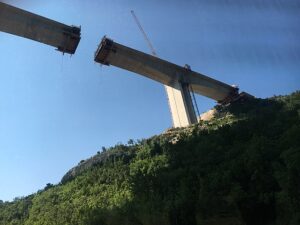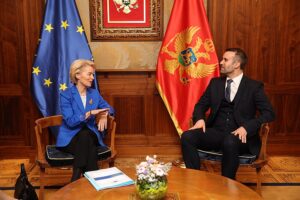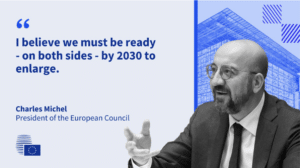After Montenegro had asked the European Union (EU) for a bailout for a loan to China’s Exim Bank, the EU stated that it would not “repay loans from third parties”. This in itself might sound logical, but given the context of growing Chinese influence in the region, it is also a failed opportunity for the EU. With Montenegro’s government now running out of options to repay the 1 billon dollar loan, which the previous government committed itself to, its “dept dependency” on China grows. Helping out Montenegro’s new patriotic government, while the country heavily dependent on tourism is struck hard by the COVID-19 pandemic, could have been a good first step as part of their renewed commitment to enlargement to the Balkan region.
Montenegro’s previous government commits itself to unrealistic project
Reports released from 2006 to 2012 on the proposed Beograd–Bar motorway, running from landlocked Serbia to Montenegro’s coast, already warned its construction would be economically unviable. Despite this, Montenegro’s previous government committed itself to the project. At the time, the EU was unwilling to loan Montenegro the money due to the project’s financial infeasibility, after which Montenegro turned to China. The project excellently connected the many other infrastructure projects, which China is currently running. It was willing to lend Montenegro the staggering 1 billion dollar fee, which was estimated for the construction of the highway. A Chinese company, Road and Bridge Corporation (CRBC), was allowed to do the construction work, promising lower costs and a shorter time-period than its competitors.
Alarm bells have gone off repeatedly over the last few years. Experts had warned that the highway construction and 1 billion dollar loan, with a fixed interest of 2%, was a huge strain on the tiny country, accounting for a fifth of its entire economy. Before 2014, MANS, an EU-financed anti-corruption watchdog, urged Montenegro’s government to refrain from the project before calculating its potential revenue. The estimated costs of the entire highway were 23.8 million dollar per kilometer, which would be the highest in Europe. Costs continued to soar, as the government failed to account for currency swings and several consecutive deadlines were not met by the CRBC. As such, in 2018 Montenegro was listed by the Centre for Global Development as being at risk of a debt crisis after having taken out the Chinese loan.
Montenegrin debt crisis looms as payment due date nears and COVID-19 pandemic hits
Montenegro’s government had already started redrafting funds in 2015. As the payment due date neared, pressure on the government intensified. With a state debt which amounts to 97% of the country’s GDP, Montenegro was already struggling with its finances. The Socialist Party (PSP) under Milo Dukanovic has been trying to get a grip on the country’s budget since Montenegro’s independence from Serbia in 2006. It has sought to do so through tighter fiscal discipline, with an increase in taxes and cuts in public spending. However, in March of 2020 the government had to let go of this ambition as the country was struck by the COVID-19 pandemic. With tourism contributing to 25% of Montenegro’s GDP the country was especially struck hard and its government needed to relax its tight fiscal discipline. The economy shrank by 15% in 2020.
Newly installed government turns to EU as it runs out of options
In December of 2020 parliamentary elections were held in Montenegro, which drastically changed the country’s political landscape. The Democratic Party of Socialist (DPS), which had been in power for 30 years in Montenegro, failed to gain a majority of the seats despite becoming the largest party again. This allowed three other coalitions of opposition parties to take the initiative and form a government. The newly installed government faced the almost insurmountable challenge of getting the country back on its feet, considering the country’s poor financial situation. The new government immediately raised concern about the Beograd–Bar motorway project. In earlier 2014 debates the opposition parties had firmly opposed the project, which they now had come in charge of managing themselves.
When asking for support of the EU, the new government has been putting emphasis on the fact that it was the previous government that made this bad deal with the Chinese. It has stated that it was still thankful of the Chinese for providing Montenegro this opportunity, but is mostly critical of the CRBC construction company. The lack of progress and rising costs are partly blamed on the CRBC delays. In its outreach to the EU, Deputy Prime Minister Dritan Abazovic raised problems with the CRBC that another project inside the EU, namely the controversial construction of a bridge from mainland Croatia to Peljesac, has faced. It did not matter though, as the EU stood by its point that it would not “repay loans from third parties”. It was willing, however, to help Montenegro finance the next two sections of the highway.
Currently only one of three sections of the highway is under construction. Without the second two sections the motorway would be of little use. Despite the construction putting immense pressure on the country’s economy, it is important to note that when finalized the infrastructure project would yield important benefits. As Montenegro’s first highway it would connect it to EU’s transportation system. This is the reason that even the current government, which was initially opposed to the project, it looking for ways to finalize it. The most challenging first section, trespassing Montenegro’s mountainous terrain and with average cost of nearly 40 million dollar per kilometer, is nearly finished. With the EU’s commitment to help finance future construction, the government is at least sure Montenegro can yield the benefits in the long-run.
EU’s refusal ‘missed opportunity’ as part of re-orientation strategy towards Balkans
The opportunity for the EU to bail-out Montenegro by helping it repay its loan to China’s Exim Bank had previously been described as an “easy win” and “low-hanging fruit” for the EU in April of 2020. The Financial Times made an important point then already, as it could have been a significant outreach to the candidate-member of the EU. The decision not the help Montenegro’s new government with the loan might be somewhat surprising, also considering the fact that EU spokeswoman Ana Pisonero did say that the EU was concerned with “the socioeconomic and financial effects some of China’s investments can have”. There seems to be a trend though, in which the EU fails to live-up to its restated commitment to the Western Balkans. The EU’s recent decision is another missed opportunity and a “green light” for China.
According to a European Investment Bank study, Beijing had handed out about 13 million dollar in loans for construction projects from 2007 to 2017 across the globe. Of that 13 million dollar 33% went to Serbia, 12% to Bosnia-Herzegovina and 7% to Montenegro. This shows the extent to which China is investing in the region, thereby gaining more and more influence. If Montenegro would not be capable of paying back the loan, it could be asked to hand over control of its shore for a fixed number of year. China has been filling the gap left by the EU, which despite maintaining the largest investor and donor to the region, has received more and more competition. With regards to COVID-19 as well, Western Balkan countries are forced to resort to China and Russia for their vaccination and medical equipment.
Montenegro itself is reaching out to the EU, hoping to reduce its dependency on China and Russia. In 2017 it decided to join NATO and it heavily invests in becoming an EU member. Despite Montenegro seeking closer ties with the West, its economic ties remain close to the East. Its economy relies heavily on Russian tourists and investors and is now becoming dept dependent on China as well. A bailout could have been an important first step towards strengthening the country’s economic ties with the West. Even though it might initially sound logical that the EU does not “repay loans from third parties”, given all of these circumstances, Montenegro’s bailout would have not been so illogical after all. The EU have now already come back on their earlier statement and agreed to “explore options on how to provide support”.
Image: Wikimedia (Moračica bridge, Montenegro)
Sources: AA, BalkansInsight, Bloomberg, Clingendael, EmergingEurope, Euractiv, Ewb1, Ewb2, GlobalTimes, Intellinews, Rferl, Reuters, WashingtonPost



